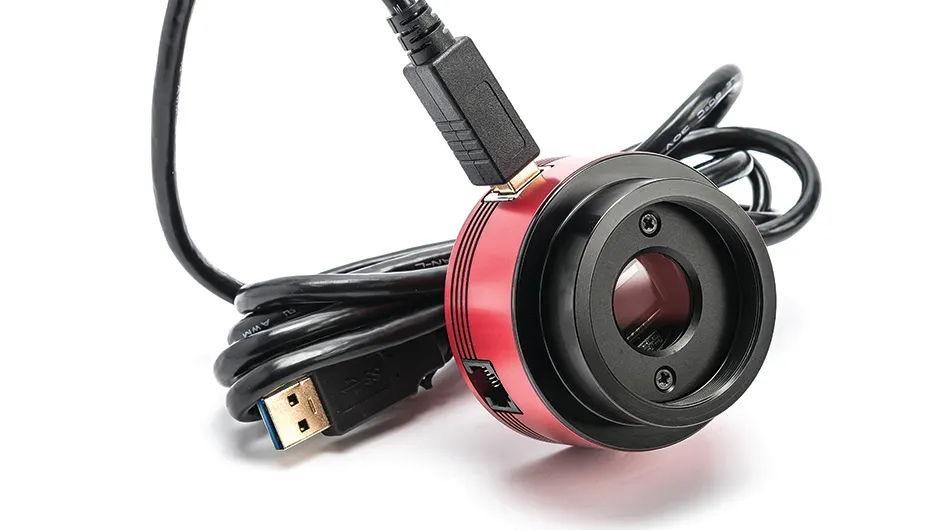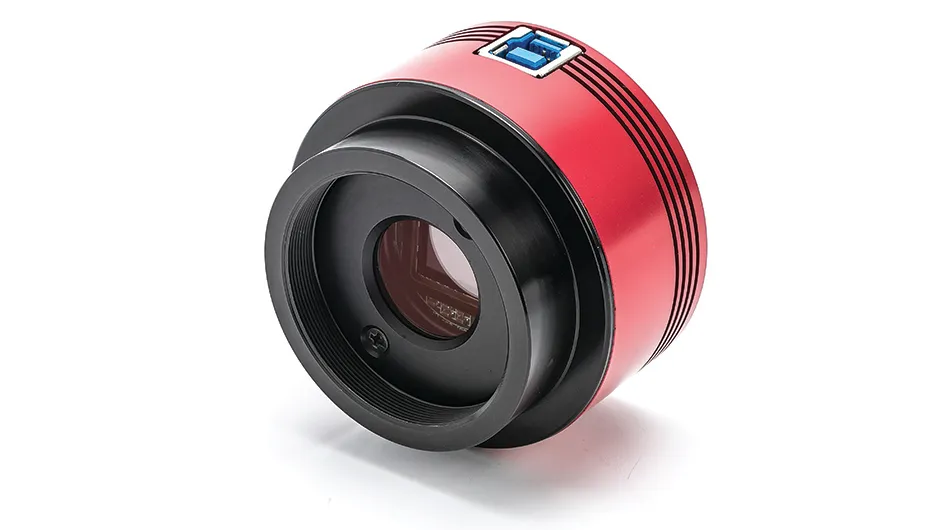Price: £549.00
Weight: 140g
Supplier: 365Astronomy
Telephone: 02033845187
Website: www.365astronomy.com
The ASI174MM is a monochrome high frame rate camera. It’s a USB 3.0 device, capable of some blisteringly fast frame rates.
What’s exceptional about it is that it can achieve these rates using the whole of the sensor but, with a full array of 1,936x1,216 pixels, you’d better make sure there’s plenty of free space on your hard drive.
The peak delivery rate is determined by the exposure time, the size of the pixel array and the bit-depth of the image being captured.
Like many modern high frame rate cameras, it’s possible to create a ‘region of interest’ on the chip.
When this is active, only the pixels within the region of interest are used.
This reduces the amount of data sent down the connection port and provides the opportunity for the camera’s frame rate to go even higher.
At full frame, the ASI174MM can deliver 128 frames per second (fps) in its 12-bit mode and 164fps in 10-bit mode.
The number of bits of a pixel determines how many grey tones it can represent and is equal to two to the power of the bit-depth: 10-bits give 1,024 tones and 12-bits give 4,096 tones.
In theory, the higher bit-depth should give greater tonal fidelity to the final result. To be honest, for a lot of subjects, the difference isn’t that obvious.
Frame rate is important when imaging Solar System objects because the fine detail they present can be badly affected by Earth’s turbulent atmosphere.
Recording lots of still frames in rapid succession increases the chances of capturing the fleetingly short periods of good seeing that occur.
Freeware applications such as RegiStax and AutoStakkert! can then be used to extract, align and average those images to produce a smooth, distortion-free end result.

Mosaics made easier
The high frame rate means that the camera can fill a hard drive very quickly and from our experience, a minimum 100GB of free space is recommended per session.
The ASI174MM is perfectly matched to capturing large, extended targets such as the Sun and Moon, and removes a huge amount of work when producing mosaics.
Using a Celestron C14 telescope (14-inch aperture, f/11) at prime focus, we were able to create a mosaic of an 84%-lit Moon using just 22 panes. The end result was just over 6,000 pixels square.
At the other end of the spectrum, an ED80-style scope (3-inch aperture, f/7.5) could easily produce a full disc image of the Sun on the camera’s chip.
For the planets, the full sensor area is less important unless you want, for example, to create a family portrait of Jupiter or Saturn with their moons.
For disc-only shots the region of interest comes into its own, with a much smaller area on the chip being used to record just the planet’s disc.
As well as its amazing Solar System imaging capabilities, the ASI174MM can also be used for deep-sky imaging too. Its capabilities here are quite respectable due to the chip’s low noise.
You won’t match the output from a dedicated cooled CCD camera, but you can still get decent results.
Just to add further value to its capabilities, the camera is also equipped with an ST-4 compatible autoguiding port, allowing you to use it as a guide camera.
The ASI174MM comes with a set of drivers and basic control software.
However, we’d recommend downloading the latest drivers from
the ZWO website. Similarly, the most common control software used is the freeware FireCapture, which standardises the control interface for a variety of cameras.
This is a fantastic all-round camera capable of imaging Solar System objects as well as deep-sky targets.
Its forte is producing spectacular, large-area captures of bright objects such as the Sun and Moon.
Although other cameras, including earlier cameras from ZWO themselves, have encroached on this capability, the amazing frame rate offered by the ASI174MM makes it a first-class performer for this sort of application.

Making the high frame rate work for you
The ASI174MM deserves the high frame rate title. However, you need to pay attention to the settings to get the best out of it.
A fast USB 3.0 computer, preferably with a solid state drive, is also required for best performance.
We reached the top frame rate of 164 frames per second (fps) full frame, while imaging the bright Sun and Moon.
However, our 1,000-frame test captures resulted in an average fps drop as our laptop’s 5,600rpm hard drive struggled to keep up.
This camera was superb for capturing large areas of bright targets, even considering the reduced averages achieved.
For the planets, the 1,936x1,216 is overkill, so we used a region of interest to reduce data overhead.
Here, frame rate is more limited by the sensitivity of the chip and exposure used.
For example, using a 9 millisecond exposure on Jupiter limited our frames per second to the number of 9 millisecond intervals there are in 1 second – in this case, 111.
On a bright planet like Venus, we managed to achieve nearly 400fps using the same setup because we could use a shorter exposure.
Autoguider port
This versatile camera provides an ST-4 compatible autoguider port.
For deep-sky imaging, the ASI174MM can be inserted into a guidescope and connected to a suitable mount by a supplied 2m cable.
An ASCOM driver is available from the ZWO website, allowing the camera to be used by programs such as the popular PHD autoguiding software.
Camera body
The ASI174MM’s aluminium body produces a lightweight 140g device.
Two connection ports are provided: one for USB 3.0 and one for autoguiding.
The main opening is a low profile 2-inch barrel, internally T-threaded (M42x0.75).
A 1.25-inch adaptor is supplied as standard.
A standard tripod threaded hole is provided at the rear of the camera.
Image quality
The Sony IMX174LLJ sensor has a low read noise (6e/15e in low/high speed modes) with a quantum efficiency of 78 per cent, peaking around 500nm (blue-green).
It also has no fixed pattern noise, an effect that can produce unwanted regular patterns in images.
Consequently, the processed results are excellent quality.
Sensor
The camera uses a 1/1.2-inch (13.4mm) CMOS Sony IMX174LLJ sensor, offering 1,936x1,216 pixels each 5.86μm square.
The chip uses a global shutter, so avoiding unwanted motion distortion.
Regions of interest are supported, as well as a 2x2 binning mode for high sensitivity applications.
The sensor is mounted behind an anti-reflection coated optical window.
USB 3.0 port
The ASI174MM requires a USB 3.0 connection for full-speed operation.
It can be connected to a USB 2.0 port but full frame capture rates drop to around 18fps.
The supplied 2m cable has a USB 3.0 type A plug for the computer connection and a USB 3.0 type B plug on the camera end.
This review originally appeared in the August 2015 issue of BBC Sky at Night Magazine.
